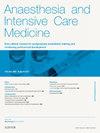Applied cardiovascular physiology
IF 0.3
Q4 ANESTHESIOLOGY
引用次数: 0
Abstract
Maintaining an equilibrium between oxygen supply and demand is a principal function of the cardiovascular system. In times of altered metabolic demand, mechanisms exist to maintain the balance between supply and demand. Exercise, haemorrhage and pregnancy all lead to changes in oxygen demand and subsequently modification of cardiac output. During isotonic exercise, metabolic demands of muscle are greatly increased. Sympathetic stimulation and inhibition of the parasympathetic system lead to increases in heart rate and venous return, increasing cardiac output. This allows a proportional increase in blood flow to the exercising muscle. Cardiac output increases throughout pregnancy. In the first and second trimesters this rise is mainly due to an increase in stroke volume; however, during the later stages of pregnancy stroke volume reaches a plateau and further increase in cardiac output is mediated by a rising heart rate. In contrast, during haemorrhage, decreased venous return leads to a reduction in cardiac output, with a baroreceptor response due to the drop in arterial blood pressure. The tachycardia and vasoconstriction which follows are compensatory mechanisms in an attempt to preserve blood pressure. The Valsalva manoeuvre illustrates several aspects of reflex control of the cardiovascular system and allows non-invasive assessment and quantification of control mechanisms. Changes in stroke volume during the respiratory cycle can be used to predict fluid responsiveness and can be measured as pulse pressure variation or stroke volume variation.
应用心血管生理学
维持氧气供给和需求之间的平衡是心血管系统的主要功能。在代谢需求改变时,存在维持供需平衡的机制。运动、出血和怀孕都会导致需氧量的改变,并随之改变心输出量。在等渗运动中,肌肉的代谢需求大大增加。交感刺激和抑制副交感神经系统导致心率和静脉回流增加,心输出量增加。这使得运动肌肉的血流量成比例地增加。心输出量在怀孕期间增加。在妊娠早期和中期,这种上升主要是由于卒中量的增加;然而,在妊娠后期,脑卒中量达到平稳期,心输出量进一步增加是由心率上升介导的。相反,在出血期间,静脉回流减少导致心输出量减少,由于动脉血压下降而产生压力感受器反应。随后出现的心动过速和血管收缩是为了维持血压的代偿机制。Valsalva操作说明了心血管系统反射控制的几个方面,并允许对控制机制进行非侵入性评估和量化。呼吸周期中搏量的变化可用于预测液体反应性,并可通过脉压变化或搏量变化来测量。
本文章由计算机程序翻译,如有差异,请以英文原文为准。
求助全文
约1分钟内获得全文
求助全文
来源期刊

Anaesthesia and Intensive Care Medicine
ANESTHESIOLOGY-
CiteScore
0.50
自引率
0.00%
发文量
152
期刊介绍:
Anaesthesia and Intensive Care Medicine, an invaluable source of up-to-date information, with the curriculum of both the Primary and Final FRCA examinations covered over a three-year cycle. Published monthly this ever-updating text book will be an invaluable source for both trainee and experienced anaesthetists. The enthusiastic editorial board, under the guidance of two eminent and experienced series editors, ensures Anaesthesia and Intensive Care Medicine covers all the key topics in a comprehensive and authoritative manner. Articles now include learning objectives and eash issue features MCQs, facilitating self-directed learning and enabling readers at all levels to test their knowledge. Each issue is divided between basic scientific and clinical sections. The basic science articles include anatomy, physiology, pharmacology, physics and clinical measurement, while the clinical sections cover anaesthetic agents and techniques, assessment and perioperative management. Further sections cover audit, trials, statistics, ethical and legal medicine, and the management of acute and chronic pain.
 求助内容:
求助内容: 应助结果提醒方式:
应助结果提醒方式:


